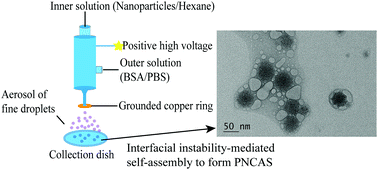Producing protein–nanoparticle co-assembly supraparticles by the interfacial instability process†
Abstract
Originally discovered in fundamental research of nanomaterial–biomolecule interactions, protein–nanoparticle co-assembly supraparticles (PNCAS) have become an emerging class of nanomaterials with various biological applications. We apply the interfacial instability process, which was originally reported for forming nanoparticles-encapsulated polymeric micelles, to produce PNCAS. By doing so hydrophobic nanoparticles, which are often the product formed from the upstream nanoparticle synthesis step, can be directly used as the raw materials of the production process of PNCAS. On the other hand, we take advantage of the structural features of protein molecules, in comparison with amphiphilic block copolymers, to mitigate two common problems encountered in the original interfacial instability-mediated nanoparticle encapsulation process, namely (1) poor encapsulation number control and (2) inconvenience and high cost to vary the assembly size. Additionally, we achieve semi-continuous and scalable production of PNCAS by combining the electrospray process and the interfacial instability process. We also conduct proof-of-concept studies of biological applications of the PNCAS products.



 Please wait while we load your content...
Please wait while we load your content...